 On February 23, 2016, elected leaders from twelve Tribal Nations convened in Washington, D.C. and met in consultation with then Deputy Secretary Krysta Harden and Acting Deputy Secretary Michael Scuse of USDA, and Under Secretary Kevin Concannon and Deputy Under Secretary Katie Wilson of the Food, Nutrition and Consumer Services of USDA. The meeting brought together Chairmen, Chairwomen, Presidents, Governors, Tribal Chiefs, and Tribal Council Representatives to discuss the landscape of nutrition programs in Tribal communities. Jefferson Keel, Lieutenant Governor of the Chickasaw Nation of Oklahoma (pictured to the right), opened the meeting with a request to seat a working group of Tribal leaders to consult regularly with USDA. Lieutenant Governor Keel then opened the floor for his fellow Tribal leaders to speak directly to USDA leadership on what they view as the outstanding issues related to the Food Distribution Program on Indian Reservations (FDPIR) and the needs in Indian Country in general. Tribal leaders spoke passionately about FDPIR, the important role it plays, and the need and interest to look to improvements, both legislative and regulatory, for the program. The discussion also included increasing access to traditional foods in the food package, enhanced nutrition education opportunities, and the availability of more funding for local FDPIR operations. Tribal leaders, along with staff at USDA, are exploring options to continue the important dialogue in the future.
|
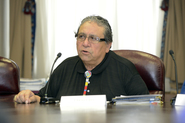
Great-grandson, student, bookkeeper, father, FDPIR director,
advocate, NAFDPIR president, storyteller – Red Gates has fulfilled many roles
throughout his life, and his dedication and passion have catalyzed positive
changes to FDPIR and the food package. Red, Program Director of the Food
Distribution Program for the Standing Rock Sioux Tribe since 1982, shares his
experience and memories for this edition of FDPIR Connection.
The Standing Rock Sioux Reservation occupies 2.5 million
acres in south-central North Dakota and north-central South Dakota. Standing
Rock FDPIR serves nine communities and an average of 824 households each month,
approximately 1,900 people. Approximately five truckloads of regular food and
four truckloads of produce arrive each month, and participants may come to the
warehouse to pick up their food any time. The program also offers tailgating,
due to the size of the reservation, and home deliveries to eligible households,
such as those who are elderly, handicapped, shut-in, or without transportation.
Red recounted his childhood. Red’s mother died when he was
four years old, and his great-grandparents raised him and his younger sister.
His great-grandmother imparted to Red her spirituality and religion, and his
great-grandfather passed along a strong work ethic: “If you can build it, build
it. If you can fix it, fix it.” The family grew most of its own food in the
garden. Red later attended boarding school and after graduating from high
school moved to California, where he studied accounting and bookkeeping and got
a job. A couple years later, a draft notice brought him back to North Dakota.
Red began working for the tribe in 1969 as a bookkeeper, and
in 1970, he was hired permanently and held different jobs related to finance,
planning, and development. When the War on Poverty brought federal programs through
the Office of Economic Opportunity and Office of Native American Programs,
Red’s skills as a budget writer and planner served his tribe well. After the program
Red worked on was later defunded, he was delegated to another program in
trouble. The commodity program – which was ordering and distributing food without
keeping proper records and submitting reports – was in danger of being turned
over to the state of North Dakota. While Red thought that directing the
commodity program was not his ideal job, he thought he’d try it out for a
while. That was in February 1982, and 34 years later, he’s still there!
Red has been involved with NAFDPIR, the National Association
of FDPIR, since the very beginning. In 1989, Red was invited to a meeting with
the Oklahoma and New Mexico tribes in Oklahoma City. At this meeting they
decided they needed a national organization, and NAFDPIR was created. Each
Region had a Vice President, and in 1989 Red was elected alternate VP for the
Mountain Plains Region, and became VP a year later when the first one stepped
down. During a planning visit for the 1993 NAFDPIR conference, hosted by the
Mountain Plains Region in Denver, the President of NAFDPIR mentioned to Red he
would not be running for re-election and told Red, “I want you to. You’ve got
all the ability and aggressiveness.” Red had never visualized himself as a
leader, but after consulting his tribal chairman and family decided to run and
was elected President in 1993.
Red went on to serve three additional terms as NAFDPIR
President because he took over for three other Presidents who resigned. He is
no longer on the national board but remains involved as a historian and on the
marketing and legislative committees. His contributions include authoring the
first resolution that created the Food Package Review committee, which has played
a valuable role in improving the food package. Red’s understanding of business
and marketing has further allowed him to appreciate the value of the food
package.
Red was instrumental in bringing pilot programs to his
tribe. His starring role in a 1990 hearing on hunger – the House Select
Committee on Hunger selected his tribe as one of the sites – earned him an
invitation to a hunger forum from USDA Secretary Mike Espy. Conversations there
prompted Red to ask participants what they would like to see, and the response
was hamburger meat. Red wrote a paper about a pilot, and his tribe was selected
as the pilot program for fresh frozen ground beef. Presaging the MyPlate advice
to make half your plate fruits and vegetables, Red requested the addition of
fresh fruits and vegetables such as apples, oranges, grapefruit, red potatoes,
onions, and carrots to the food package at a June 1993 meeting with Food and Nutrition Service (FNS)
leadership in Nebraska, and the pilot project for fresh fruit and vegetables
for FDPIR was born.
While popular foods vary among communities, Red highlighted
several favorites among his clients: ground beef, bison, chicken breast, fresh
produce, juices, seasonal items such as wild cherries, cheese, and cream of
mushroom soup. Red is also optimistic about the new whole wheat tortillas
because the clients really like tacos and burritos. His program hosts weekly
food demos and provides handouts and cookbooks created by the Mountain Plains
Nutrition Education committee. A new produce cookbook for seasonal food was
distributed in May.
What does the future hold, for Red and FDPIR? He doesn’t
have in mind a date for retirement and feels there is more work to be done. At
first he wasn’t convinced by the store concept, but he’s seen other tribes make
it work and would like to stick around to see all the programs explore a store
concept. Red never in his wildest dreams imagined he would be where he is
today; he just wanted to help where he could and wasn’t afraid to ask
challenging questions. He loves the program, understands the needs of the
people, and appreciates all the support and mentoring that has guided him. As
Red and his wife are now raising five grandchildren, he is fueled by a desire
to provide food to kids who need it in the hopes that they will grow into
healthy individuals.
Red would like to give recognition to the Standing Rock
Sioux Tribe and, especially, to the Standing Rock Sioux FDPIR staff for always
supporting him and for taking care of the program’s most important services to
the participating households. He also thanks his wife and family for their
support as he has had to be away from home many times during his tenure with
FDPIR, and he is grateful to his friends at USDA/FNS, other Tribes, and members
of Congress who have provided encouragement, mentoring, and assistance.
In the immediate future, he’s going to the NAFDPIR
conference in early June, and will maybe have a few things to say there. We
would expect nothing less from this passionate pioneer.
|
USDA is delighted to announce the relaunch of the FDPIR Sharing Gallery, a resource for nutrition education, recipes and cookbooks, grant opportunities, photos and videos, news and newsletters, and presentations and training. We invite you to visit this new, collaborative website for ideas to incorporate into your local FDPIR program, and you may also contribute content to be posted to the Sharing Gallery by sending an email to USDAFoods@fns.usda.gov.
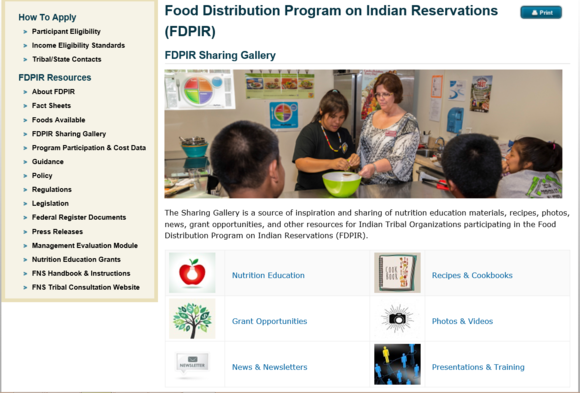

In Indian Country, culture and tradition are sustained through shared meals
with family and the community. Traditional foods are a powerful way for each new
generation to connect with and honor its history and its ancestors.
Bison and blue cornmeal have recently graced the tables of participants in
USDA’s Food
Distribution Program on Indian Reservations (FDPIR) thanks to the joint
commitment of the Agricultural Marketing
Service and Food and Nutrition
Service, working with the FDPIR community to identify and procure foods
traditional to many tribes. Last year, AMS awarded two contracts to Native
American-owned small businesses to deliver frozen, lean ground bison meat to
FDPIR. From November 2015 to the end of June 2016, these companies are on
schedule to deliver a total of 520,000 pounds of bison meat. A third contract
was awarded for whole-grain blue cornmeal. This product was received by tribes
during the 2015 holiday season for use in a wide variety of recipes and cultural
dishes. Read more
|
Direct Certification: An Overview for Indian Tribal Organizations and State Agencies Administering the Food Distribution Program on Indian Reservations (FDPIR): This document provides information on the purpose of Direct Certification, its benefits, the role of FDPIR administrating agencies in the FDPIR-Direct Certification process, and important items to consider prior to participating in a data-sharing partnership.
 Agreement to Share and Exchange Data - MOU- FDPIR Direct Certification: This document provides language and structure which can be used as the foundation for a Memorandum of Understanding (MOU) between FDPIR administrating agencies and State Child Nutrition Program agencies for Direct Certification data exchange. The MOU document includes a sample format for data description and requirements (Appendix A), as well as useful legal references (Appendix B). Please note that document serves as a Template for your use and reference, and the use of this document as provided is not required. FDPIR staff should confer with their Tribe’s legal staff prior to implementing any MOU for data-sharing.
|
AIS Participant By Birthdate/Direct Certification AIS User Guidance: AIS user guidance providing step-by-step instructions to generate the electronic file needed by State agencies to conduct FDPIR-Direct Certification.
Contact your Regional Office for these Direct Certification resources.
SNAP-Ed and Rural Development
Resource Documents
In conjunction with our
colleagues in the Supplemental Nutrition Assistance Program (SNAP) and Rural Development, the Food Distribution Division developed two resource documents
that describe, at a high level, funding available through SNAP-Ed
(nutrition education) and Rural Development (infrastructure and equipment).
These documents were created in response to interest from our Tribal community
on learning more about additional funding streams to support nutrition
education activities and/or infrastructure and equipment needs at the local
Tribal level. Both documents are available on the FDPIR Sharing Gallery: FDPIR and SNAP-Ed and FDPIR and Rural Development.
On March 16-17, the Sherwood Valley Distribution Program and Western Association of Food Distribution Programs on Indian Reservations (WAFDPIR) Nutrition Education Advisory Group co-facilitated the second annual Western Region Nutrition Education Symposium at Northwest Indian College located at the Lummi Nation Reservation in Ferndale, Washington. Funded in part by a Food Distribution Nutrition Education Grant, the convening brought together Tribal directors, nutrition educators, certification technicians, and warehouse staff from Indian Tribal Organizations (ITOs) administering FDPIR throughout the Western region.
The goal of the Symposium was to expand on the previous year’s convening to provide nutrition education information and resources in a train-the-trainer format to stakeholders involved with FDPIR nutrition education programming. Topics included garden-based nutrition education; factors that influence food choice; intersecting personal and worksite wellness; promoting healthy food choices in a variety of food distribution settings; incorporating traditional, local, and USDA Foods to foster healthy eating; conducting effective cooking demonstrations; and nutrition education applications for digital storytelling. Symposium sessions featured a mix of presentations, hands-on small group activities, and interactive physical activity breaks. Presenters and facilitators included content experts from ITOs, Northwest Indian College, and USDA FNS staff from the National and Western Regional Offices. Tribal elders from Lummi Nation shared personal stories of how practicing traditional ways throughout their life positively impacted their health and wellness. Participants enjoyed a traditional foods dinner and Sla-Hal traditional hand game. The Symposium concluded with participants identifying strategies for implementing nutrition education activities for FDPIR participants within their communities and creating individualized nutrition education activity plans.
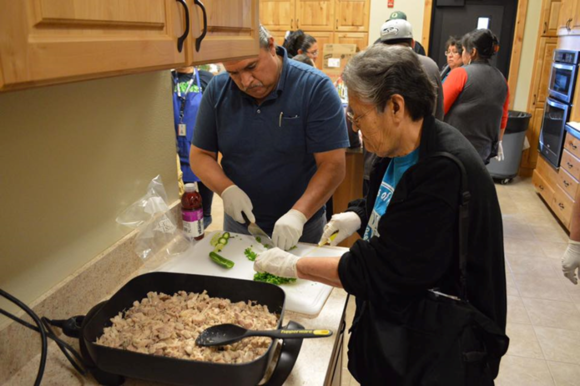 Symposium participants compete in an Iron Chef Cooking Challenge using healthy recipes featuring traditional and USDA Foods.
Publication of Donated Foods Final Rule
FNS published a Final rule in the Federal Register, Requirements for the Distribution and Control of Donated Foods & The Emergency Food Assistance Program: Implementation of the Agricultural Act of 2014, on April 19, 2016. This rule revises and clarifies FNS regulations to ensure that USDA Foods are distributed, stored, and managed in the safest, most efficient, and cost-effective manner, at State and recipient agency levels. The rule also reduces administrative and reporting requirements for State distributing agencies, revises or clarifies regulatory provisions relating to accountability for USDA Foods, and rewrites much of the USDA Foods regulations at 7 CFR part 250 in a more user-friendly, “plain language,” format. Lastly, the rule revises and clarifies specific requirements in The Emergency Food Assistance Program to conform more closely to related requirements in 7 CFR part 250 and current law. View the final rule here.
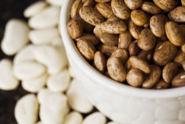 Nutrient and Food Group Analysis of USDA Foods in Five of Its Food and Nutrition Programs
USDA has published the Nutrient and Food Group Analysis of USDA Foods in Five of its USDA Food and Nutrition Programs. The report contains food and nutrient analyses of the USDA Foods distributed through five household and Child Nutrition feeding programs for Fiscal Year (FY) 2014 and School Year (SY) 2013-2014.
Key findings of the report for foods offered and delivered through FDPIR in FY 2014 include:
● FDPIR offered and delivered at least 100 percent of the Dietary Reference Intakes (DRI) recommendations for protein, carbohydrates, vitamin A and C, several B vitamins, and iron;
● As offered, FDPIR packages provided 95 percent of participants’ energy needs; and
● As delivered, FDPIR packages provided participants with most (84 percent) of their energy needs.
View the summary and full report
|
 Inspect What You Expect
USDA purchases and ships USDA Foods to ITOs and State agencies. It is the ITO’s/State
agency’s responsibility to ensure that each truck load of USDA Foods received is
inspected as it is being unloaded. This helps avoid problems later. The
ITO/State agency should examine each shipment, prior to accepting and unloading
USDA Foods. At the time of delivery, check the following:
- Verify temperatures for
refrigerated and frozen products are appropriate to assure that the foods are
in good condition;
- Inspect product for damage or
infestation, as well as shortages or overages in the shipment. Indicate these
items on the bill of lading (BOL) and give it back to the driver; and
- Confirm that security seal is
intact and that seal number matches number on the BOL. Notify the FNS Regional
Office or Food Distribution Division if security seal is broken, missing, or the
number does not match BOL.
Best Practices for
Receiving USDA Foods:
Are
you interested in guidance on the administration of FDPIR? Review FNS Handbook 501 for FDPIR.
The Complaint Team is available Monday-Friday, 6:00 a.m. – 5:00
p.m. Eastern Time. Email USDAFoodsComplaints@fns.usda.gov or call the USDA
Foods Complaint Hotline at 800-446-6991.
|
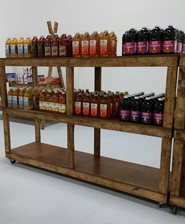 FDPIR participants of the Spirit Lake Sioux Tribe in North Dakota are eating healthier and now have fresher and more varied food choices as part of a move to a new FDPIR distribution site.
In recent years Spirit Lake’s FDPIR had seen an increase in participation due to policy changes that simplified and improved administration to expand access to the program. To keep up with the participation increase and a desire for a more appealing experience, local FDPIR staffers made sweeping changes. They secured funding to move to a new warehouse they knew could accommodate their plans. Now consumers can pick up their food at a warehouse that’s been redesigned to mimic a more traditional grocery store shopping experience. Several tribes in other U.S. regions have this model, but this is a first for the Mountain Plains Region.
“It was a challenge to move, and there has been a learning curve for everyone,” said Mary Greene-Trottier, FDPIR Director, “but there have been so many positive effects from this and the clients are very happy.”
|
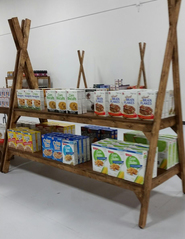 Trottier said the new system also allows for more flexibility where participants can return more than once a month to pick up their monthly food package based on established guide rates for their household. She also said that her clients enjoy that they can see, touch, and feel food before they select it.
The current distribution site is also home to the Benson County SNAP office. While participants in FDPIR cannot simultaneously receive SNAP benefits, Trottier sees opportunities to partner in offering nutrition education to beneficiaries of both programs.
|
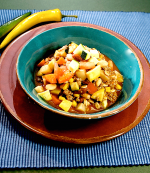 This hearty stew is great for dinner and even better the next day. It uses different ingredients like sweet potatoes and quick cooking oats.
The recipe's name comes from the three main Native American crops it features: corn, beans, and squash.
This recipe can also be found in the cookbook A Harvest of Recipes with USDA Foods and on the What's Cooking? USDA Mixing Bowl site. Watch this YouTube video demonstrating how to prepare the recipe!
Ingredients
1/2 pound ground beef (or Bison)
1 cup onions (diced)
3 cups water
3 cups red potatoes (cubed, or 1 1/2 cans, about 24 ounces, low-sodium sliced potatoes, drained)
2 tomatoes (diced, or 1 can, about 15 ounces, low-sodium tomatoes, drained)
1 can low-sodium tomato sauce
1/2 cup frozen corn kernels (or 1/4 can, about 4 ounces, low-sodium whole kernel corn, drained)
1/2 cup yellow squash (diced, or 1/4 can, about 4 ounces, low-sodium sweet potatoes, drained and diced)
1/2 cup green squash (diced, or 1/4 can, about 4 ounces, low-sodium carrots, drained)
1/2 can low-sodium kidney beans (drained)
1/2 can low-sodium vegetarian beans
1/4 cup quick cooking oats
2 cloves garlic (finely chopped)
1/4 teaspoon salt
1/4 teaspoon black pepper
Directions
1. In a small skillet, brown ground beef and onions over medium to high heat for 8 to 10 minutes. Drain fat. 2. In a large pot, combine cooked ground beef, water, and red potatoes. 3. Bring the pot to a boil and cook for 15 minutes. 4. Add all the other ingredients to the pot and bring to a boil. Lower heat and simmer for about 25 minutes.
Notes
Tip for cooking ground beef: The recommended safe minimum internal temperature for ground beef is 160 degrees F, as measured with a food thermometer.
|
 Helpful Resources for WBSCM Users
Several
useful resources are available for new and experienced users alike that provide instructions, guidance, and general support information to help them work proficiently with Web-Based Supply Chain Management (WBSCM). These materials are regularly updated to correspond to the current best practices, application enhancements, and system requirements to provide convenient solutions to common questions.
USDA Website: Technical information and news about WBSCM on the public website includes Technical Information & Tools such as system requirements, browser settings, and technical tips; Upload/Download Guidelines & Templates for bulk updates and data integration with other systems; and a Newsletter Archive, which contains updates and reminders about WBSCM features, upcoming events, and Service Desk-recommended solutions to common problems.
WBSCM Forum: When logged in to WBSCM, users can see one or more discussion forums, depending upon their role in the system. These are used to announce new software releases, system outages, changes to browser or system requirements, upcoming deadlines, etc. Within WBSCM, navigate to Home -> News and Alerts.
Work Instructions: Step-by-step instructions and screenshots are available for common processes. These can be located by browsing by role and business function: Internal/External, Fulfillment/Procurement, and Domestic/International. A keyword search tool is also available after selecting a category. These materials can be accessed as simple or detailed instructions; many can also be viewed as interactive on-screen simulations. Within WBSCM, navigate to Help -> Training -> Work Instructions.
Job Aids: These are miscellaneous references to assist users with WBSCM. Examples include general instructions for running different types of reports, helpful hints, guidance for using wildcard characters in searches, and business rules. These resources are grouped by category: Finance, Fulfillment, Procurement, and Reports. Within WBSCM, navigate to Help -> Training -> Job Aids.
Release Notes: WBSCM is under continuous development to address known issues and/or introduce new or enhanced features. A description of the changes, the roles impacted, and links to related instructions are published with each release. Within WBSCM, navigate to Help -> Training -> Release Notes. The newest items can be found at the bottom of the list.
Hands-on Training: The WBSCM training environment (NTRN) is available for a variety of user roles. This safe environment provides trainers, trainees, and those who just want to practice using WBSCM with a copy of production data from 11/1/2013 from WBSCM for training on reports, placing orders, and more—all without impacting any real account activity. Contact the main WBSCM Service Desk at 877-WBSCM-4U (877-927-2648) or by email to WBSCMHelp@ams.usda.gov if you want access to NTRN.
|
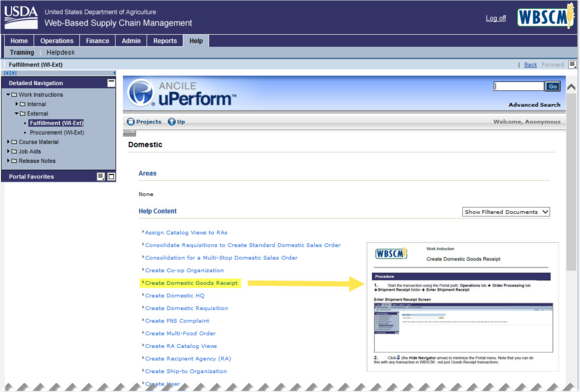 WBSCM Work Instruction Example
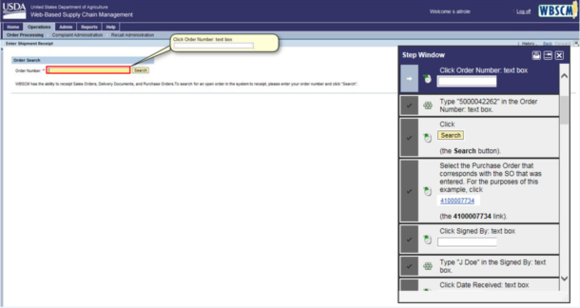 WBSCM Simulation Example
 USDA Staff attend the NAFDPIR Conference in 2008
USDA staff will be participating in this upcoming national meeting in 2016. We look forward to the opportunity to meet you and hope to see you there!
June 6-10: The 29th Annual NAFDPIR Conference to be held in the Cherry Capital of the World, Traverse City, Michigan
On June 6, Tribal members from across the country representing 276 federally recognized Tribes will come together for opening ceremonies in Traverse City, Michigan. The annual conference of the National Association of Food Distribution Programs on Indian Reservations (NAFDPIR) will feature a week-long gathering where local food distribution staff may attend sessions on food systems, nutrition education, eligibility and certification, and warehouse operations. The theme of this year’s conference is “Traveling the Path to Our Traditional Ways.”
|
Here's how to sign up for these updates via GovDelivery:
1. Go to the Food Distribution website.
2. Click on the red envelope on the row of social media icons on the top right of the page.
3. Enter your email address and click "Submit."
4. Check the boxes to select your topics of interest. For these e-letters, scroll down to the Food Distribution category and click the plus sign to the left of the check box to expand the list and view all the sub-categories. Check these sub-categories to receive the corresponding e-letters:
*USDA Foods --> receive all "USDA Foods from Farm to Plate" general + program-specific e-letters
*Commodity Supplemental Food Program (CSFP) --> receive "Household Highlights" e-letter
*The Emergency Food Assistance Program (TEFAP) --> receive "Household Highlights" e-letter
*Food Distribution Program on Indian Reservations (FDPIR) --> receive "FDPIR Connection" e-letter
*Schools/Child Nutrition Commodity Programs --> receive "Spotlight on Schools" e-letter
5. Update your subscription preferences any time by following the above steps or clicking on the Subscriber Preferences Page link at the bottom of any of the e-letter email messages you receive from GovDelivery. Questions? Contact us at USDAFoods@fns.usda.gov
|
|